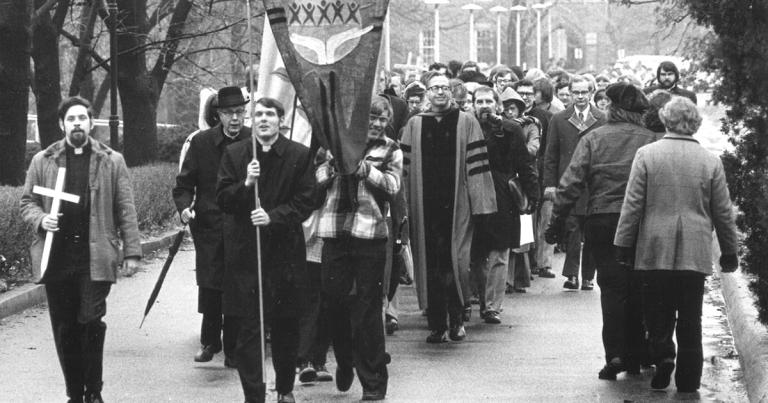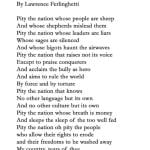This year marks the 50th anniversary of the split in the Lutheran Church Missouri Synod known as the SEMINEX [seminary in exile] walkout, in which its liberal seminarians and their professors ceremonially walked out of the denomination–as did, eventually, most of its liberal pastors and congregations–leaving the LCMS in solidly orthodox hands.
The American Spectator, a prominent conservative magazine, has an article in its Spring issue by Tom Raabe entitled How a Church Fought Back Against a Liberal Takeover — And Won. It gives a blow-by-blow account of the controversies that culminated in the walkout. And it praises the LCMS for being one of the few church bodies that has successfully resisted a concerted internal effort to make it go liberal.
Raabe’s article is so good and so instructive for other traditions facing similar pressures that I urge you read it in its entirety. I will get you started, then give you a few thoughts of my own:
Rarely if ever in American religious history has a Christian church body been able to repulse a concerted attempt by professional theologians to lead that church into the darkness of theological liberalism.
But that was what happened fifty years ago when theologically conservative laity and pastors rescued the Lutheran Church–Missouri Synod from such a fate. In 1974, 90 percent of the faculty (forty-five out of fifty professors) at the denomination’s foremost seminary, Concordia Seminary, and approximately 80 percent of the students walked off the St. Louis campus and into “exile” to start their own theologically liberal institution. Eventually, the group took about two hundred of the church body’s six thousand congregations with them, thus forming the Association of Evangelical Lutheran Churches.
It is a story with all the drama one would expect from a modern church splintering in plain sight. It featured tempestuous church conventions, rebellious student convocations, pompous faculty orations, protests and press conferences, and all the militant accouterments — black armbands and the like — one would expect of a winner-take-all showdown in the tumultuous 1970s. It ended with a theatrical exodus event that included a mock funeral for the seminary, boarded-up arches and gateways, the planting of memorial crosses on campus grounds, defiant speeches, and a triumphal march away from the campus into self-imposed exile.
The Theological Tempest
In a time when churches split over positions on sexual proclivities or thinly disguised political issues, if there is a silver lining to this particular ecclesiastical fissure, it is that, in a bizarre way, it is refreshing to see a church body fracturing over what the church should be about in the first place, that is, theology — or, more specifically, biblical interpretation.
That’s how this squabble started. It stemmed from the adoption of a hermeneutical method called historical criticism by certain members of the faculty of Concordia Seminary.
Historical criticism is a product of the Enlightenment, the age when science and reason were in ascendancy. It focuses on biblical hermeneutics, treating God’s written Word as though it is to be interpreted as a merely human document that is in principle no different from any other piece of ancient writing. By rejecting the notion of divine inspiration, historical criticism undermines the Bible’s authority, denies its miracles, and dismisses its historical accounts.
This method is a cornerstone of liberal theology and is widely utilized in the hermeneutical practices of mainline Protestants, including Presbyterians, Episcopalians, Methodists, and liberal Baptists and Lutherans. The Lutheran Church–Missouri Synod had avoided its taint until, in the early 1960s, reports began to filter through pastoral and lay ranks that certain professors at the seminary had embraced this interpretive method.
I remember following all of this as a young graduate student who had grown up in a mainline liberal denomination, recently discovered the Bible, and had become more or less a generic campus evangelical. I came across a comment by the evangelical theologican and cultural critic Francis Schaeffer who said that in the “Battle for the Bible”–which was raging in virtually every theological tradition–the Lutheran Church Missouri Synod was the only major denomination in which the liberals left to form their own small church body, while the conservatives kept hold of the denomination and its infrastructure.
Consider, for example, the very recent case of the Methodists. Even though the conservatives dominated the ruling church convention, which re-affirmed the denomination’s opposition to homosexuality, the liberal church hierarchy fixed it so that the conservatives had to leave to form a new denomination.
Later, I remembered Schaeffer’s comment when my wife and I moved to a new city and were looking for a church to join. We checked out the local congregation of the Lutheran Church Missouri Synod and the rest is history. I guess I owe my Lutheranism to the SEMINEX walkout.
I’m not saying that this made it all worthwhile. Every schism is traumatic for a church body. Congregations were split, friendship were broken, and families were rent asunder. The walkout is still a sore subject fifty years later for many of those who are old enough to have gone through it.
But still, it was a defining event for American Lutheranism. The small American Evangelical Lutheran Church (AELC), formed by those who walked out became the catalyst for uniting all of the Lutheran denominations that had chosen to make themselves mainline liberal Protestants into one denomination: the Evangelical Lutheran Church in America (ELCA). More significantly, the exodus of the liberals from the Lutheran Church Missouri Synod secured its identity as a church body that confesses the Bible, Jesus Christ, and the Gospel of salvation.
So important is the SEMINEX walkout to Lutheranism today that we discuss it in my book Embracing Your Lutheran Identity.
For a detailed account of what happened, read Rediscovering the Issues Surrounding the 1974 Concordia Seminary Walkout, a Concordia Historical Institute monograph edited by Ken Schurb.
Photo: Members of the faculty and student body of Concordia Seminary, St. Louis, participate in the “Walkout” on Feb. 19, 1974, by Paul Ockrassa, via Reporter: The Official Newspaper of The Lutheran Church—Missouri Synod














